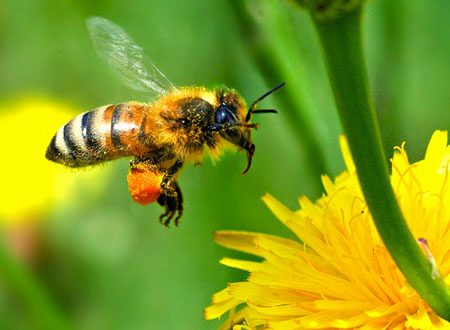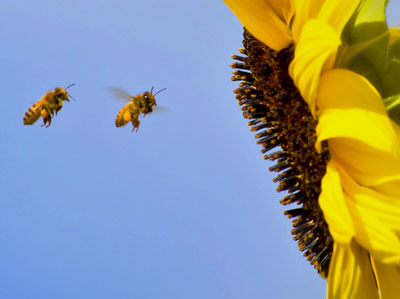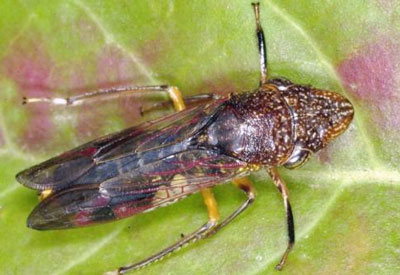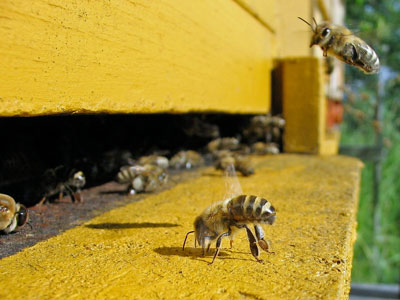
STANDING AT THE CROSSROADS (Part I)
ADAPTIVE VARIETY SELECTION AND THE UNCERTAIN ROLE OF IMIDACLOPRIDS IN THE FUTURE OF SOUTHERN GRAPE CULTURE
By: R.L. Winters, Fairhaven Vineyards
Master Horticulturist/Ampelographer Fairhaven American Hybrid Research Foundation
[VT – Please welcome back VintageTexas guest blogger R.L. Winters in this three part blog on the impact of the use of imidacloprid pesticides our grape culture in Texas and the American Southland.] Click here for Part II, click here for Part III.
— — — — —
THE MYSTERY
In the late winter of 2005 Florida beekeeper Bill Rhodes was busy working his usual day’s tasks, the drudgery of preparing hundreds of his bee colonies for shipment to the vast almond groves of California, where they would facilitating the production of an important national crop. He noticed an unusual behavior while conducting regular maintenance of the hives…
The bees responded to the routine splitting of the hives by refusing to occupy the split sections! Something he hadn’t seen before in decades of experience working with these tiny denizens of nature.
Once the broods arrived in California, Rhodes went out to inspect the hives, marking them and returning within the week to check again. “The hive would look entirely different,” Rhodes said. “It was like something just had them by the throat and was just pulling the strength from them. We had no idea what it was.” Of the sixteen semi-loads of pollinators Rhodes had shipped to the location only two were serviceable. The rest had perished.
Backtracking to where the brood had been previously contracted, led Rhodes back to a fruit farming operation in South Dakota. The farm was located immediately adjacent to vast acres of sunflowers that were literally dripping with imidacloprid.
What this simple, thoughtful, beekeeper had identified was later to become known as Colony Collapse Disorder. Overnight, Rhodes had become the unwilling Paul Revere of the basis of world crop production, shouting a warning that would circle the globe!

THIS IS THE STORY
Imidacloprid is a type of neonicotinoid insecticide that was first registered for use in the United States in 1994. The chemical compound, a synthetic form of nicotine, was originally approved for use in ornamentals, and turf application to control sucking or chewing insects. The product is marketed under many different trade names: Alias, Merit, Gaucho, Provado, Montana, Nuprid, Marathon, Adonis, Macho, and Dominion.
[VT – NOTE: Neonicotinoids are a relatively new class of insecticides that share a common mode of action that affect the central nervous system of insects, resulting in paralysis and death. They include imidacloprid, acetamiprid, clothianidin, dinotefuran, nithiazine, thiacloprid and thiamethoxam.]
The neonicotinoid compound is a highly systemic product that is readily absorbed by the crop plant. When applied, it enters the plant vascular system, undergoes complete distribution in the tissues, and renders all parts of the plant toxic to insects. One of the most remarkable aspects of the imidacloprid family of chemical compounds is its dual mode of absorption:
- Soil drench (or drip) application results in rapid transmission of the compound to the cell structure of the plant via the root system, where it is absorbed with normal water uptake.
- Imidacloprid is also unusually persistent, lasting many weeks after foliar application and with repeated applications can persist for up to 6 years in the woody parts of the treated plants and is detectable for many years after soil applications.
The amazing potency of the systemic action of the compound is clearly demonstrated by seed treatments of corn and sunflower crops that, after germination, produce highly toxic seedlings that are virtually impervious to insect attack.
A quick tour of the pesticides on the shelf at any garden center will reveal that imidacloprid has become the chemical of choice in an extensive line of products, everything from general use insecticide for killing ants, household insects, pet flea control, to use on ornamentals, and garden food crops. Homeowner use of this compound allows for rates as high a 32 times greater than that of agricultural labeling, and…
None of the existing labeling warns of severe toxicity to pollinators.
This widespread label approval is largely due to yet another unusual aspect of the compound. While it is severely toxic to insects it has a relatively low toxicity to mammals. It works by interfering with the transmission of stimuli in the insect nervous system causing irreversible blockage of acetylcholine receptors, which are found in a type of neural pathway that is more abundant in insects than in warm-blooded animals. It is effective by both contact and ingestion modes.
To understand human toxicity, for a 200 lb. human male, the amount needed to produce lethal effects, would be right at 1lb (of active ingredient) for dermal, and 1.4 ozs. oral. In the world of insecticides imidacloprids have a surprisingly low toxicity to humans, which explains how this relatively unknown compound has seen it use skyrocket to nearly 1 billion pounds worldwide!
The effect on insects is another story.
Lethal doses for many flying insects (including Sharpshooters) is an amazingly tiny amount of the product. When you consider the minute oral dose that produces a kill, it becomes clear why the compound is so devastating to the Sharpshooter (found in many Texas vineyards)!

From a grape growers standpoint, we tend to say, “Wow…..here’s the answer to problem of Pierce’s Disease!” “I’ll just keep spraying and my vines, and they will be Pierce’s free!” But, there’s a darker, more sinister side to this story.
Beginning in 2005 an apiary farmer in Florida began to notice something unusual in his business of supplying honeybees to large industrial farms for the purpose of pollination. His name was Bill Rhodes, and what he discovered will likely shape the future of grape culture in a wide-ranging area of America.
With an increasing frequency, the boxes that were used to house the bee colonies were turning up empty during the course of the pollination contracts. At first, these incidents were being written off to the standard list of bee maladies (mites, fungal disease, etc.) but later tests revealed that these diseases or other pollinator pests did not cause the failures. Another highly suspicious aspect of the failures was the nearly complete lack of dead bees in or around the boxes! Many of these boxes contain up to 30,000 foragers and if they had died due to the usual issues then areas around the boxes would have been several inches deep in dead bees!
So, where did the bees go?
THE COMMON THREAD
The common thread that runs through this mystery is the close proximity of the pollinators to agricultural (usually mono-culture operations) applications of imidacloprid.
Use of the product began in earnest after agricultural label approval for use on corn in 2000, and later neoniconoids were approved for use with other crops such as sunflowers in 2005. But how was it, if the product wasn’t being sprayed directly on the pollinators, that the chemical was destroying the colonies? All of the early testing of imidacloprid showed no immediate issues with its use as long as the pollinators were protected from the spray drift.
As in many laboratory-testing programs involving label approval by the EPA, the responsibility to test and verify the safety of the new chemical compound was left to the producers of the product (a strange dance that seems to be like having the fox watching the hen house). In the developmental phases, imidacloprid toxicity to pollinators was clearly established under existing guidelines, but apparently a critical mistake was made in understanding, not the acute results of spraying the pollinators, which reveals the usual LD50 (acute lethal) rating, but rather the effects of what is called a sub-lethal dose.
— — — — —
To be continued: Part II – NO WAY HOME

Click here for Part II.
